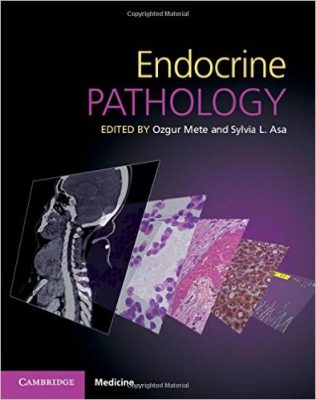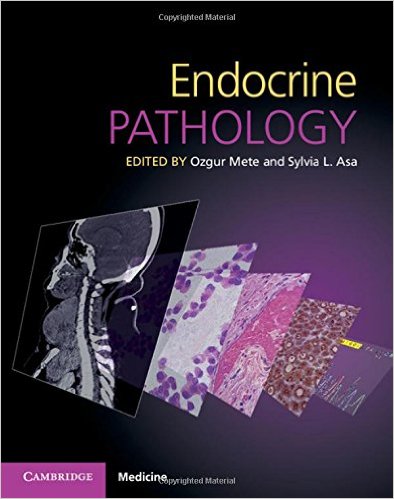 Editors: Ozgur Mete, MD, and Sylvia L. Asa, MD
Editors: Ozgur Mete, MD, and Sylvia L. Asa, MD
Publisher: Cambridge University Press – 1,075 pages
Book Review by: Nano Khilnani
The importance of endocrinology in many aspects of clinical medicine has increased in recent years as we view test results that hold clues to abnormalities, diseases and disorders in the functioning of our bodies, or human physiology.
Dr. Ozgur Mete and Dr. Sylvia Asa point out in the Preface that endocrine disorders have increased in number in the modern world, and endocrine tumors represent some of the new types of cancers that are rising in incidence these days.
Tracing the cause of these anomalies, and learning about their origins and outcomes is the subject of this large book of over a thousand pages. The rapid growth of research and knowledge in cellular and molecular biology, as well as advances in laboratory technology, has greatly helped in the understanding and treatment of illnesses in the medical specialty of endocrine pathology
Sixty-six people in various pathology specialties from all over Canada and eight other countries – Brazil, France, Italy, Japan, the Netherlands, the United States, Turkey, and the United Kingdom – wrote the chapters of this very extensive book
The editors and authors of this book are MDs and PhDs engaged in laboratory medicine, pathology, and radiology, studying and treating diseases in various organs (and related pathways around) the brain and nervous system, endocrine glands, the gastrointestinal tract, the genitourinary tract, the heart, kidneys, lungs, reproductive organs, the skin, and other areas.
The contents in this book are organized around three Sections. To give you the researcher, student or practitioner an overview of what you will (or will not) find in this large book, we present below the titles of its 30 chapters:
- Section I – Clinical Approaches
- Clinical presentation of endocrine diseases
- Familial endocrine tumor syndromes
- Immunological basis of endocrine diseases
- Section II – Investigative Techniques
- Biochemical testing
- Radiological imaging
- Cytological assessment
- Intraoperative consultations
- Morphology and immunohistochemistry
- Cytogenetic and molecular genetic testing
- Experimental models of endocrine diseases
- Section III – Anatomical Endocrine Pathology
- The brain as an endocrine organ (including the pineal gland)
- The pituitary gland
- Thyroid
- Parathyroid gland
- Adrenal cortex
- Adrenal medulla and extra-adrenal paraganglia
- Endocrine lesions of the of the gastrointestinal tract
- The endocrine pancreas
- Liver in endocrine disease
- Pulmonary, thymic, and mediastinal neuroendocrine lesions
- The kidney in endocrine disease
- Endocrine aspects of the male genitourinary system
- Endocrine lesions in the mammary gland
- The placenta
- The gynecological tract: neuroendocrine tumors and ovarian tumors with endocrine association
- Skin manifestations in endocrine disease
- Cardiovascular system in endocrine system
- Soft tissue in endocrine disease
- Bone in endocrine disease
- The approach to metastatic endocrine tumors of unknown primary site
This book provides a broad range of information and specific data on the biochemical, clinical, cytogenetic, histopathological, immunological, molecular, and radiological aspects of neoplastic and nonneoplastic endocrine disorders.
This book takes a multidisciplinary approach, so it is useful and can be appreciated by endocrinologists, internists, radiologists, and nuclear medicine specialists, oncologists, and surgeons as well. It has been written for people at different levels of their careers – medical students, interns and residents, and established practitioners.
The materials in each chapter are presented in a succinct and balanced way, employing the right amount of text and graphics. This is evident in short chapters such as in the five-page chapter 13 – The Thyroid.
This chapter presents these aspects of the thyroid gland:
Embryology
Anatomy, histology, and Ultrastructure
- Gross anatomy
- Microscopic anatomy
- Histochemistry and immunohistochemistry
- Ultrastructural anatomy
Physiology
Six micrographs are presented, along with a real-life photo of the thyroid gland, in this brief chapter. Thirty-four books and other sources of information are presented in the list of References at the end of this chapter. Numerous studies relating to the subjects covered are presented in all the chapters of this book. This is a great way to expand knowledge and broaden horizons around the field.
This is a very authoritative, valuable book on a medical specialty that is relatively rare: endocrine pathology. The book is extensive in its coverage of many topics within its area, with well-organized and well-presented information in text and graphic form. I highly recommend this book to all those who are intending to enter, or are already in the field of endocrinology, as well as oncology.
Editors:
Ozgur Mete, MD is Consultant in Endocrine Pathology in the Department of Pathology Laboratory Medicine Program in the University Health Network; and Associate Professor of Laboratory Medicine and Pathology at the University of Toronto in Ontario, Canada
Sylvia L. Asa, MD is Consultant in Endocrine Pathology in the Department of Pathology Laboratory Medicine Program in the University Health Network; and Professor of Laboratory Medicine and Pathology at the University of Toronto in Ontario, Canada






